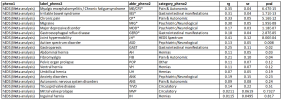Complex Genetics and Regulatory Drivers of Hypermobile Ehlers-Danlos Syndrome: Insights from Genome-Wide Association Study Meta-analysis
[Line breaks added]
Background
Hypermobile Ehlers Danlos syndrome (hEDS) is the most common subtype of EDS, a group of heritable connective tissue disorders. Clinically, hEDS is defined by generalized joint hypermobility and chronic musculoskeletal pain, but its impact extends beyond the musculoskeletal system.
Affected individuals frequently experience autonomic, gastrointestinal, immune, and neuropsychiatric involvement, highlighting both the multisystemic nature of the condition and challenges of diagnosis. In contrast to other EDS subtypes with defined genetic causes, the molecular basis of hEDS has remained elusive.
Methods
We conducted a genome wide association study (GWAS) of hEDS across three case controls studies, including 1,815 cases and 5,008 ancestry-matched controls. Fixed effects metaanalysis of 6.2 million variants was complemented with LDAK gene based association testing, transcriptome wide association studies, and integrative annotation across multiple tissues and cell types including eQTLs, enhancer marks and open chromatin accessibility profiles, supported by luciferase assays on one candidate variant.
LDscore genetic correlations were assessed between hEDS and 19 frequently reported comorbid conditions.
Results
Two loci reached genome wide significance, including a regulatory region near the atypical chemokine receptor 3 gene (ACKR3) on chromosome 2. Functional annotation supports ACKR3 risk alleles colocalize with eQTLs in tibial nerve, alter enhancer activity, and generate a de novo AHR transcription factor regulatory site, implicating neuroimmune and pain signaling pathways.
Gene-based and transcriptome wide analyses identified common variants in a locus containing multiple candidates, including SLC39A13, a zinc transporter critical for connective tissue development previously implicated in a rare form of EDS, and PSMC3, a gene involved in central nervous system development.
LDscore regression revealed significant genetic correlations between hEDS and joint hypermobility, myalgic encephalomyelitis/chronic fatigue syndrome, fibromyalgia, depression, anxiety, autism spectrum disorder, migraine, and gastrointestinal diseases.
Conclusions
These results establish the first evidence of common variant contributions to hEDS, supporting a complex, multisystem model involving neuroimmunestromal dysregulation. Our findings add novel indications to hEDS pathogenesis and provide solid foundations for future molecular definition and therapeutic discovery.
Web | PDF | Preprint: MedRxiv | Open Access
Taylor Petrucci-Nelson, Sacha Guilhaumou, View ORCID ProfileTakiy-Eddine BERRANDOU, Cortney Gensemer, Adrien Georges, Matthew Huff, Margaux-Alison Fustier, Josephine Henry, Asraa Esmael, Olivia Jaye, Ranan Phookan, Sarah Dooley, Kathryn Byerly, Brian Loizzi, Roman Fenner, Emma Mach, Amy Weintraub, Victoria Daylor, Julianna Weninger, Natalie Koren, Erika Bistran, Charlotte Griggs, Molly Griggs, Sydney Severance, Rebecca Byrd, Sunil Patel, Steven A. Kautz, Anne Maitland, View ORCID ProfileNabila Bouatia-Naji, Russell A. Norris
[Line breaks added]
Background
Hypermobile Ehlers Danlos syndrome (hEDS) is the most common subtype of EDS, a group of heritable connective tissue disorders. Clinically, hEDS is defined by generalized joint hypermobility and chronic musculoskeletal pain, but its impact extends beyond the musculoskeletal system.
Affected individuals frequently experience autonomic, gastrointestinal, immune, and neuropsychiatric involvement, highlighting both the multisystemic nature of the condition and challenges of diagnosis. In contrast to other EDS subtypes with defined genetic causes, the molecular basis of hEDS has remained elusive.
Methods
We conducted a genome wide association study (GWAS) of hEDS across three case controls studies, including 1,815 cases and 5,008 ancestry-matched controls. Fixed effects metaanalysis of 6.2 million variants was complemented with LDAK gene based association testing, transcriptome wide association studies, and integrative annotation across multiple tissues and cell types including eQTLs, enhancer marks and open chromatin accessibility profiles, supported by luciferase assays on one candidate variant.
LDscore genetic correlations were assessed between hEDS and 19 frequently reported comorbid conditions.
Results
Two loci reached genome wide significance, including a regulatory region near the atypical chemokine receptor 3 gene (ACKR3) on chromosome 2. Functional annotation supports ACKR3 risk alleles colocalize with eQTLs in tibial nerve, alter enhancer activity, and generate a de novo AHR transcription factor regulatory site, implicating neuroimmune and pain signaling pathways.
Gene-based and transcriptome wide analyses identified common variants in a locus containing multiple candidates, including SLC39A13, a zinc transporter critical for connective tissue development previously implicated in a rare form of EDS, and PSMC3, a gene involved in central nervous system development.
LDscore regression revealed significant genetic correlations between hEDS and joint hypermobility, myalgic encephalomyelitis/chronic fatigue syndrome, fibromyalgia, depression, anxiety, autism spectrum disorder, migraine, and gastrointestinal diseases.
Conclusions
These results establish the first evidence of common variant contributions to hEDS, supporting a complex, multisystem model involving neuroimmunestromal dysregulation. Our findings add novel indications to hEDS pathogenesis and provide solid foundations for future molecular definition and therapeutic discovery.
Web | PDF | Preprint: MedRxiv | Open Access

